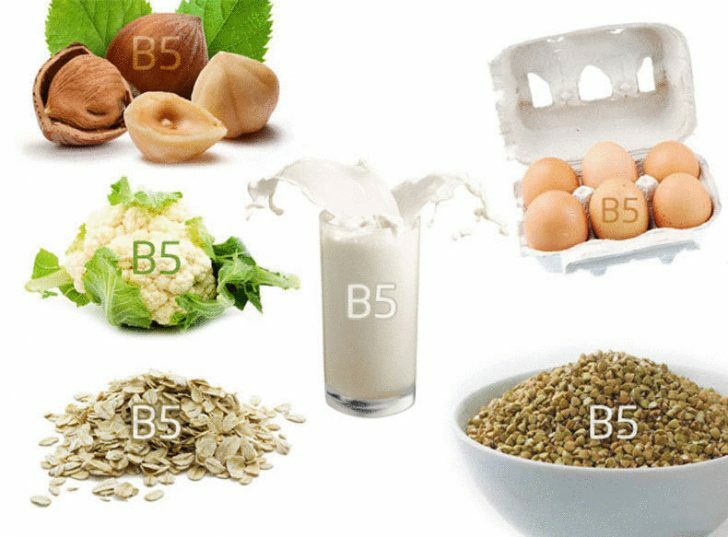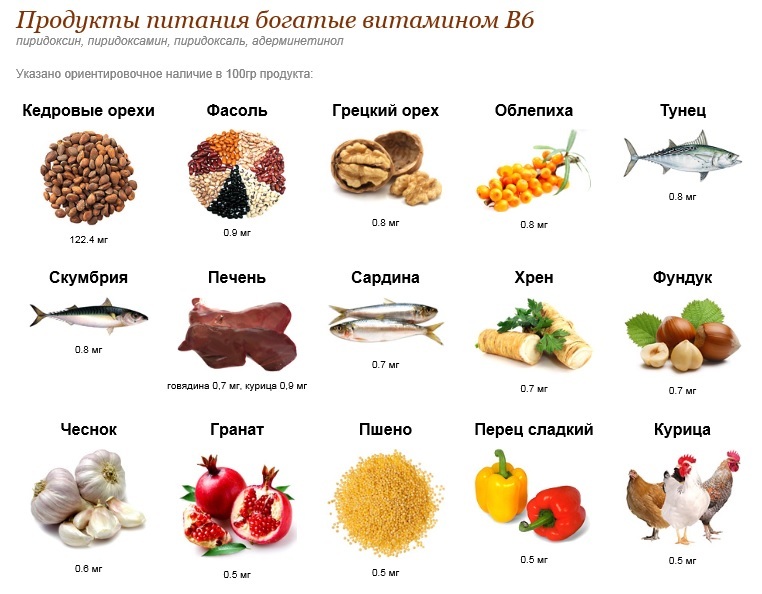B vitamins: what are needed and in which foods are contained
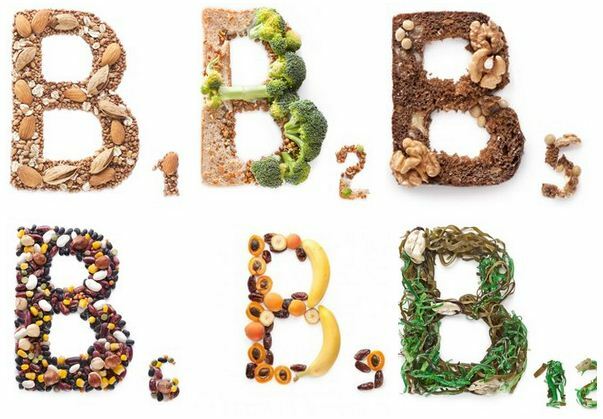
Group B vitamins are a group of water-soluble compounds that participate in all metabolic processes occurring in the body.They promote the release of energy from various nutrients in which calories are present.Preparations of vitamins of this group are widely used for the treatment of diseases of the nervous system.
Development of hypervitaminosis for water-soluble vitamins is extremely rare, as surpluses are quickly removed from the body naturally( excreted by the kidneys).
Contents: Vitamin B1( thiamine) Vitamin B2( riboflavin) Vitamin B3( PP, niacin, nicotinic acid) Vitamin B5( pantothenic acid, panthenol) Vitamin B6( pyridoxine) Vitamin B7( biotin) Vitamin B9( folic acid)Vitamin B12( cyanocobalamin)Vitamin B1( thiamin)
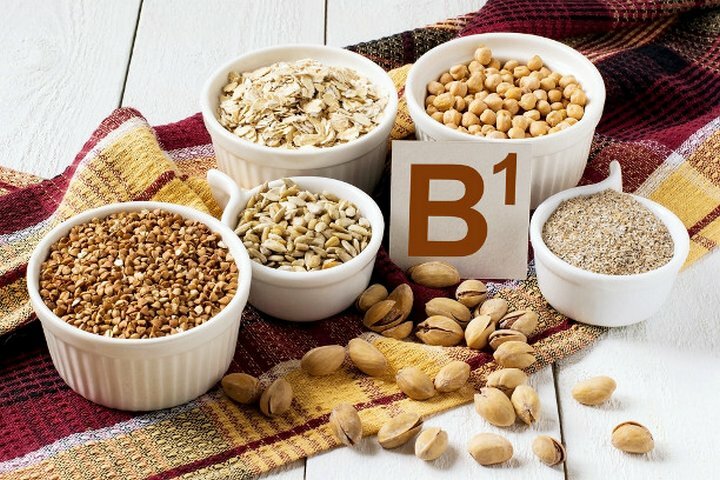 This compound is found in many products and can be synthesized in a certain amount by a normal microflora inhabiting the human intestine.During the thermal processing of food, as well as in the refining of cereal crops, thiamine is partially destroyed;At the same time, up to 25% of the vitamin is lost.
This compound is found in many products and can be synthesized in a certain amount by a normal microflora inhabiting the human intestine.During the thermal processing of food, as well as in the refining of cereal crops, thiamine is partially destroyed;At the same time, up to 25% of the vitamin is lost.
The absorption of B1 is adversely affected by the consumption of alcohol-containing beverages, coffee and food containing carbonate salts and citric acid compounds.Absorption of the vitamin is also markedly reduced in people suffering from nicotine addiction.What is Vitamin B1 for?
Thiamin is directly involved in virtually all metabolic processes( lipid and protein metabolism, as well as the assimilation of amino acids), acting at the cellular level.It is necessary to provide the body with energy.
The functional activity of the brain largely depends on vitamin B1.The compound takes part in the biosynthesis of acetylcholine, the mediator responsible for the transfer of impulses in the central nervous system.The intake of sufficient amounts of B1 significantly improves cognitive functions and memory capacity, and also provides a normal tone of the digestive tract and myocardium.Thiamine is responsible for the transmission of information at the gene level, which is carried out in the process of cell division.
In which products is B1 present?
Important: thiamine is present mainly in plant foods.In products of animal origin, vitamin B1 is relatively small.Sources of animal origin B1:
- milk( preferably - whole);
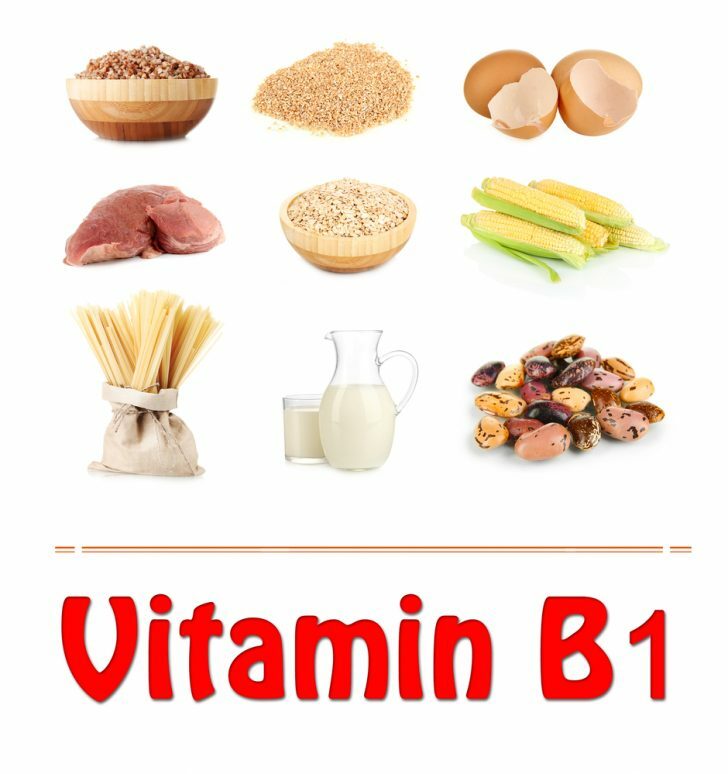 ;
; - sour-milk products( including cottage cheese and cheese);
- low-fat pork;
- eggs.
Vegetable sources B1:
- bran;
- yeast;
- sprouted grains;
- cereals;
- various cereals( oat, buckwheat and wheat);
- bakery products from wholemeal flour;
- potatoes;
- cabbage( all kinds);
- carrots;
- spinach;
- beans;
- green peas;
- onion;
- beet;
- nuts;
- apricots( including dried apricots);
- rose hips.
Norms of consumption В1
To avoid hypovitaminosis, an adult is recommended to consume an average of 1 to 2.5 mg of thiamine a day( 1.3-1.4 mg for men and 1.1-1.3 mg for women).During pregnancy, the necessary daily dose should be increased by 0.4 mg, and during lactation - by 0.6 mg.
In childhood, the need for B1 is slightly lower - from 0.5 mg for infants of the first year of life to 2 mg per day for older children.
Note : increased doses of vitamin B1 are required for physical and psycho-emotional overloads( stresses), as well as for the poisoning of the body with nicotine and heavy metals.In such situations, the recommended daily volume can be up to 5 mg, which corresponds to the maximum allowable level of consumption.
If a person regularly consumes alcohol and( or) many foods rich in carbohydrates, the need for thiamine increases.Several smaller amounts of vitamin B1 are required for people whose diet includes a lot of protein and fats.
Causes of hypovitaminosis caused by lack of B1
The main causes of thiamine deficiency in the body include:
- monotonous nutrition;
- abuse of products from fine-grain wheat flour;
- consumes a large amount of refined carbohydrates;
- consumption of products containing thiaminase( an enzyme that can destroy vitamin B1);
- chronic alcoholism( vitamin B1 vitamin deficiency is fixed in 25% of people who abuse alcohol).
Deficiency of thiamine leads to a decrease in the production of proprietary protein compounds in the body, disruption of the processes of amino acid renamination and oxidation of carbohydrate compounds.The concentration of under-oxidized products in serum and urine increases and the synthesis of the neurotransmitter acetylcholine decreases.As a consequence, the functional activity of the digestive tract, nervous and cardiovascular systems is disrupted.
Symptoms of Vitamin B Vitamin B1
Symptoms of hypovitaminosis B1 can be:
- violations of the main functions of the brain;
- is depressed;
- coordination disorder;
- memory degradation;
- irritability;
- nervousness;
- insomnia;
- muscle weakness;
- weight loss, general exhaustion;
- increased pain sensitivity;
- burning sensation in the limbs;
- paresthesia( impaired sensitivity);
- dyspeptic disorders;
- hepatomegaly;
- dyspnea against background of minimal stress;
- decreased blood pressure;
- heart palpitations;
- development of acute cardiovascular insufficiency.
Avitaminosis in particularly severe cases leads to the development of a pathology known as beriberi .
The typical clinical manifestations of this disease are:
-
 a significant deterioration in the ability to memorize;
a significant deterioration in the ability to memorize; - increased irritability( emotional instability);
- inflammation of the peripheral nerves;
- paralysis( in severe disease);
- headaches;
- chest pain( in the region of the heart);
- heart palpitations;
- shortness of breath;
- marked swelling;
- constipation( due to impaired intestinal motility);
- pain in the abdominal region;
- a sharp decrease in appetite;
- nausea and vomiting.
Indications for the appointment of thiamine
Vitamin B1 preparations are indicated for the treatment of pathologies of the cardiovascular and nervous systems, as well as for certain diseases of the digestive system and skin diseases.
Important: the need for vitamin B1 increases with the use of diuretics in the treatment of hypertension, because the process of removing water-soluble compounds from the body is accelerating.
Thiamin is given if diagnosed:
- endarteritis;
- myocarditis;
- circulatory failure;
- peripheral paralysis;
- is neuritis;
- brain dysfunction;
- peptic ulcer disease;
- enterocolitis;
- hepatitis;
- chronic gastritis;
- infringement of processes of an absorption in an intestine;
- status after operations on the stomach;
- cirrhosis of the liver;
- eczema;
- pustular skin inflammation;
- skin itch of any origin;
- psoriasis.
Hypervitaminosis
Prolonged( course) parenteral administration of thiamine preparations sometimes causes kidney dysfunction( development of deficiency), impaired enzymatic systems of the liver and fatty degeneration of this organ.
Vitamin B2( riboflavin)
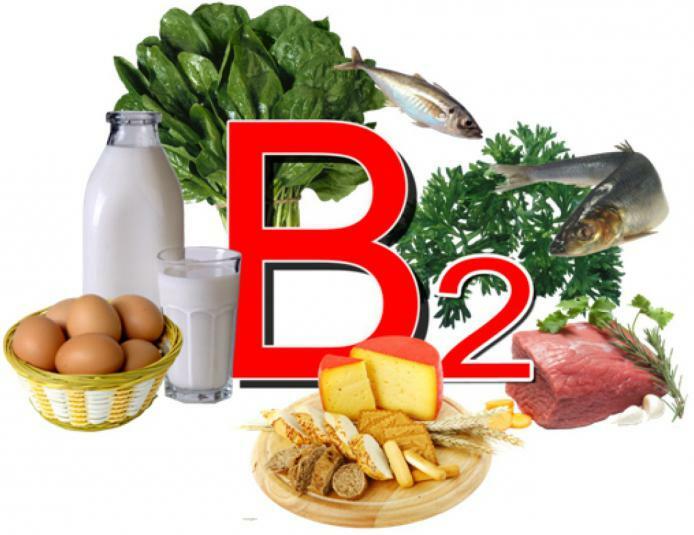 This compound, also known as an antiseborrhoeic vitamin, enters the body in an alimentary way( ie, with food) and is produced by a microflora that lives normally on the walls of the large intestine.
This compound, also known as an antiseborrhoeic vitamin, enters the body in an alimentary way( ie, with food) and is produced by a microflora that lives normally on the walls of the large intestine.
When heat-treated food products, an average of a fifth of riboflavin is lost, but it is established that vitamin B2 is rapidly destroyed during defrosting, and also under the influence of ultraviolet( in particular, solar) radiation.
Riboflavin is needed by the body to create new nerve cells, ripen red blood cells and assimilate such a vital element as iron.B2 regulates the volume of hormone production by the adrenal glands.The compound is one of the constituents of rhodopsin, which protects the retina from UV rays.
Where is riboflavin contained?
Important : Vitamin B2 is better absorbed by the body when it comes with products of animal origin.Animal products containing B2:
- pork, beef and other meats;
- fish;
- liver of animals and fish;
- eggs( protein);
- whole cow's milk;
- cheese;
- yogurts;
- pressed curd.
Vegetable sources B2:
- bakery products from wheat flour;
- tomatoes;
- cabbage;
- cereals( oat and buckwheat);
- green peas;
- leafy greens( lettuce, etc.);
- rose hips;
- yeast.
Riboflavin consumption standards
Adults per day require an average of 2 mg riboflavin( 1.3-1.5 mg for women and 1.5-1.8 mg for men).Pregnant women need an increase in intake of 0.3 mg per day, while breastfeeding mothers need 0.5 mg.
Breasts up to 6 months need 0.5 mg of vitamin per day, and babies from 6 months to 1 year - 0.6 mg.For children under 10 years of age, the requirement gradually increases from 0.9 to 1.4 mg per day.
Hypovitaminosis
With B2 deficiency, the following develops:
- stomatitis;
- swelling of the tongue;
- "jam"( cracks and small ulcers) in the corners of the mouth;
- dermatitis in the face and neck;
- photophobia;
- lacrimation;
- burning sensation in the eyes;
- "night blindness";
- a sharp deterioration in appetite;
- headaches;
- dizziness;
- reduced physical activity and performance;
- growth retardation( in children).
Indications for receiving riboflavin
Preparations B2 are administered if the patient is diagnosed with:
- hypoacid gastritis;
- Hemeralopia( "night blindness");
- dermatitis;
- thyrotoxicosis;
- eye diseases( keratitis and conjunctivitis, cataract);
- anemia;
- Addison's disease;
- cirrhosis of the liver;
- Botkin's disease;
- radiation sickness;
- chronic hepatitis;
- intestinal pathology( colitis and enteritis);
- rheumatism;
- poisoning with salts of heavy metals.
Hypervitaminosis
Excess vitamin B2 has no toxic effects, as the mucous membranes of the gastrointestinal tract can absorb riboflavin in amounts that are dangerous to the body.
Vitamin B3( PP, niacin, nicotinic acid)
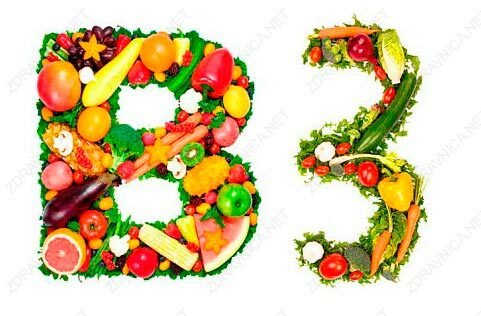 Vitamin B3 is the most stable compound of this group.It enters the body with food, and it also forms during the biotransformation of the amino acid tryptophan.
Vitamin B3 is the most stable compound of this group.It enters the body with food, and it also forms during the biotransformation of the amino acid tryptophan.
Why is Niacin Necessary?
B3 takes part in the biosynthesis of a number of enzymes, as well as in the assimilation of nutrients, the release of energy from them.Vitamin is able to normalize the metabolism of cholesterol and stimulate carbohydrate metabolism.Niacin is necessary for the production of a number of hormones( including sex and insulin).B3 provides normal functional activity of the central nervous system and stimulates the formation of erythrocytes.Niacin helps reduce blood pressure.
Where is nicotinic acid contained?
Niacin( B3) is present mainly in animal products.In plant products, its content is much less.
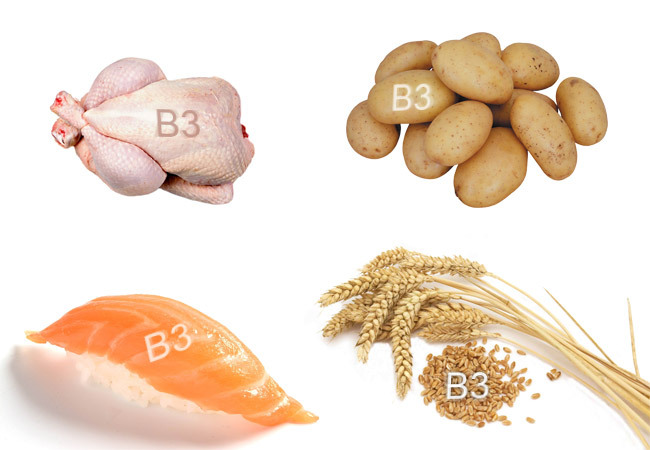
Animal sources of the vitamin PP:
- lean meat;Beef and pork liver
- ;
- fish;
- eggs.
Herbal products:
- garlic;
- parsley greens;
- cabbage;
- pepper;
- carrots;
- green peas;
- buckwheat groats;
- leguminous crops( in particular - soybean);
- most species of fungi.
Hypovitaminosis B3
Important: The causes of hypovitaminosis may be the same type of food or malnutrition.Lack of nicotinic acid is often noted in the adherents of a vegetarian diet.
For the deficiency of niacin, the following clinical manifestations are characteristic:
- increased fatigue;
- muscle weakness;
- sleep disorders;
- soreness of the tongue;
- pale skin of the face and hands;
- dry skin;
- degradation of memory ability.
Prolonged hypovitaminosis for vitamin B3 can lead to the development of pellagra.The disease is accompanied by severe impairment of the digestive system, skin and nervous system damage.Mental disorders are not excluded.
Note: deficiency of niacin accompanies such diseases as hypertension, atherosclerosis, thyroid pathology, gastritis, rheumatism and gallbladder inflammation.
Norms of consumption B3
Adults in the day require an average of 20 mg of nicotinic acid.The acceptable( safe) amount is 60 mg.The norm for children is from 6 to 20 mg, depending on the age.
Hypervitaminosis
Hypervitaminosis in vitamin B3 can adversely affect the liver.One of the signs of exceeding the recommended dose is hyperemia of the facial skin.
Vitamin B5( pantothenic acid, panthenol)
Panthenol is found in a variety of food products and is produced in small quantities by intestinal microflora.
Vitamin B5 is destroyed by heat treatment if the pH of the medium is shifted to the acidic or alkaline side.
Why do I need vitamin B5?
Panthenol promotes energy production from food.It is necessary for the cleavage of lipids and carbohydrate compounds, as well as the biosynthesis of neurotransmitters and antibodies.B5 is involved in the regeneration of tissues and the formation of the hormone of the adrenal gland.Pantothenic acid takes part in the process of hemopoiesis.
Where is B5 present?
Animal products containing in itself B5:
- pork, beef and other meats;
- liver;
- by-products;
- egg yolk;
- poultry meat;
- milk and dairy products.
Vegetable products that are considered to be sources of B5:
- legume crops;
- green vegetables;
- cauliflower;
- red beet;
- nuts( hazel);
- mushrooms;
- brewer's yeast.
Consumption norms B5
Adults per day need to consume 4 to 7 mg panthenol.Children need 2 to 5 mg, depending on the age.
Hypovitaminosis
Because B5 is present in a wide variety of products, it is extremely rare to encounter its deficiency.
In the absence of panthenol, the following symptoms of are possible:
- sleep disturbances;
- lethargy;
- fatigue;
- depression;
- paresthesia and pain in the lower limbs;
- various metabolic disorders;
- dyspeptic disorders;
- disorders of the nervous system.
Indications for the prescription of drugs B5
In the form of calcium pantothenate, vitamin is prescribed in the following pathologies:
- neuralgia;
- polyneuritis;
- tuberculosis;
- bronchitis;
- skin burns;
- Eczema;
- hyperthyroidism;
- Pregnancy toxicosis;
- of dyskinesia of the intestine( or atony in the postoperative period).
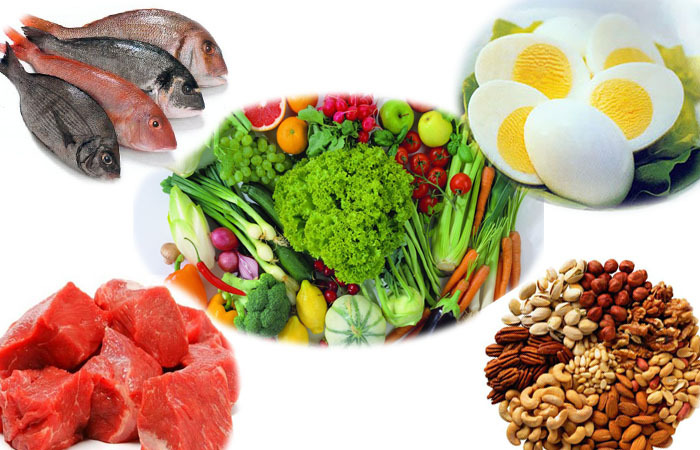
Vitamin B6( pyridoxine)
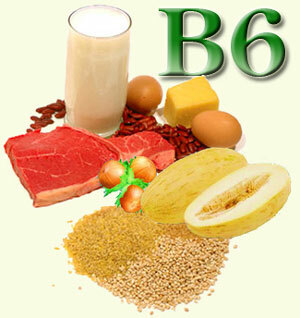 Vitamin B6 is a family of related water-soluble compounds with a similar chemical structure.The group combines such compounds as pyridoxine( it is included in the drugs most often), pyridoxal and pyridoxamine.
Vitamin B6 is a family of related water-soluble compounds with a similar chemical structure.The group combines such compounds as pyridoxine( it is included in the drugs most often), pyridoxal and pyridoxamine.
The organism receives B6 mainly by an alimentary route.A certain amount of this biologically active compound is produced by the intestinal microflora.The process of biosynthesis is disrupted against the background of antibiotic therapy;The use of antibacterial agents is a common cause of hypovitaminosis.When cooking foods, a significant portion of the vitamin is lost.Pyridoxine, although quite resistant to heat, quickly collapses under the influence of light.
Why do I need vitamin B6?
B6 takes part in almost all metabolic processes and regulates the activity of several dozens of enzymes.Pyridoxine allows the body to absorb proteins and unsaturated fatty acids.Vitamin is necessary for the biosynthesis of prostaglandins, which are responsible for the regulation of cardiac activity and the level of blood pressure.
Due to the effect of pyridoxine on the synthesis of antibodies and the process of cell division, immunity is strengthened.The functional activity of the central nervous system depends on B6.Pyridoxine is involved in the synthesis of a number of mediators of the nervous system( dopamine, norepinephrine and serotonin), which are responsible for the emotional mood and the brain as a whole.Vitamin improves the condition of the nails( makes them more durable and less brittle) and skin( increases elasticity).
Pyridoxine is needed for the transfer of genetic material.It affects the production of hydrochloric acid by the glands of the stomach, as well as the biosynthesis of hormonal compounds and hemopoiesis( in particular - the formation of red blood cells).What products contain a lot of vitamin B6?
Sources B6 of animal origin:
- poultry meat;
- veal;
- low-fat pork;
- beef liver.
Vegetable products containing B6:
- bakery products from coarse flour;
- cereals( buckwheat and millet);
- potatoes;
- tomatoes;
- carrots;
- pepper;
- cabbage( white);
- leafy greens;
- Citrus;
- strawberry;
- cherry;
- nuts( hazel and walnut).
Norms of consumption
For an adult, the daily average is 2 mg of pyridoxine( 1.8-2.2 mg for men and 1.6-2.0 mg for women).During pregnancy, it is recommended to increase intake by 0.3 mg, and during breastfeeding - by 0.5 mg.
Babies of the first year of life require 0.5-0.6 mg of pyridoxine per day.Children from one year to 3 years need 0.9 mg of vitamin B6, 4 to 6 - 1.3 mg, and 7 to 10 - 1.6 mg of pyridoxine.
Hypovitaminosis
Vitamin B6 deficiency leads to the development of the following symptoms:
- drowsiness;
- anxiety;
- increased irritability;
- diseases of mucous membranes;
- dermatitis;
- anemia( in children);
- decreased immunity;
- peripheral neuritis;
- is a dyspeptic disorder.
Important : hypo- and vitamin deficiency in vitamin B6 is especially dangerous for infants on artificial feeding, pregnant women( especially against early toxicosis and gestosis), women taking birth control pills( hormonal drugs).Lack of pyridoxine worsens also the condition of patients suffering from joint diseases, chronic liver pathologies and atherosclerosis.
Indications for the beginning of taking vitamin B6 medications
Pyridoxine is indicated if the patient is diagnosed with:
- anemia;
- decreased leukocyte count;
- Pregnancy toxicosis;
- radiculitis;
- neuritis;
- neuralgia;
- Parkinsonism;
- hepatitis.
Note: pyridoxine is also indicated for seasickness.The need for vitamin B6 increases with stress, as well as against the abuse of alcohol and with nicotine addiction.
Hypervitaminosis
An excess of vitamin B6 is possible when consumed at daily doses exceeding 6 mg.Hypervitaminosis can cause nervous illness.
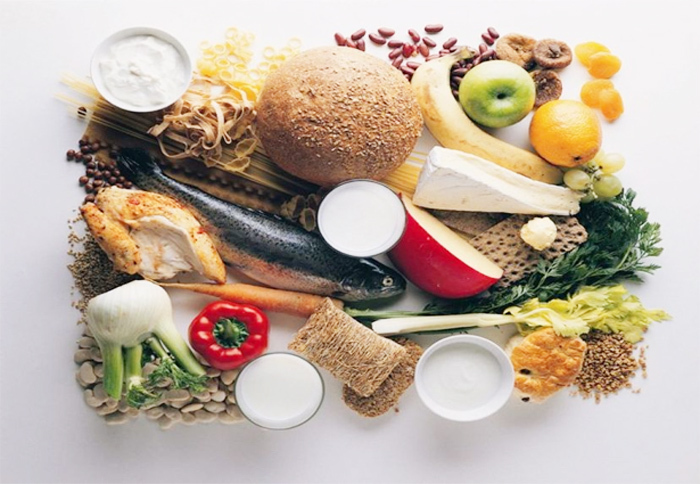
Vitamin B7( biotin)
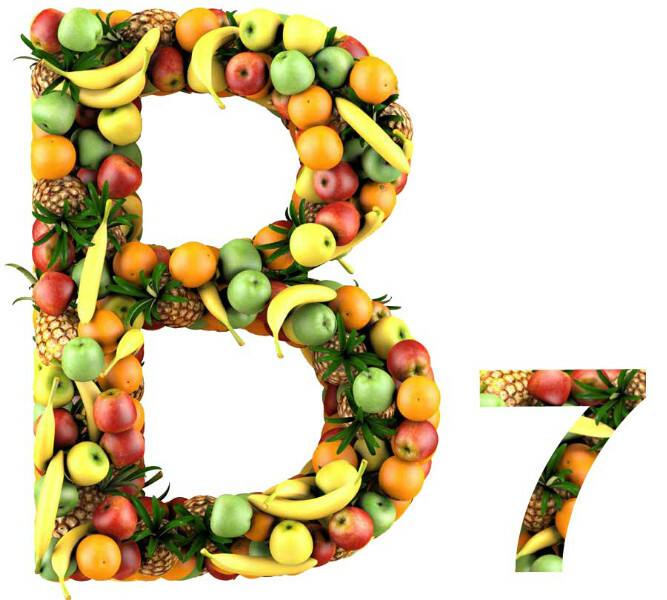 Vitamin B7 is stable in the culinary processing of products.
Vitamin B7 is stable in the culinary processing of products.
Why do we need biotin?
Biotin activates the enzymes produced by the digestive system.B7 is also of great importance for the normal flow of metabolic processes.Vitamin is required for cell division and transfer of hereditary information.
Where is B7 contained?

Animals products:
- beef liver;
- egg yolk;
- milk;
- marine fish.
Vegetable products - sources B7:
- rice;
- parsley greens;
- peas;
- nuts;
- bananas;
- brewer's yeast.
Daily requirement
On the day an adult needs 30-100 μg of B7.The maximum safe amount is 150 mcg.
Gipovitaminosis caused by B7 deficiency
Biotin deficiency can be associated with the consumption of raw eggs, the protein of which interferes with the absorption of the vitamin, as well as with the abuse of alcoholic beverages.The symptoms of hypovitaminosis are:
- anemia;
- seborrhea;
- depression;
- sleep disorders;
- lack of appetite;
- myalgia;
- is a dyspeptic disorder;
- dry skin;
- elevated cholesterol;
- high blood sugar.
Vitamin B9( folic acid)
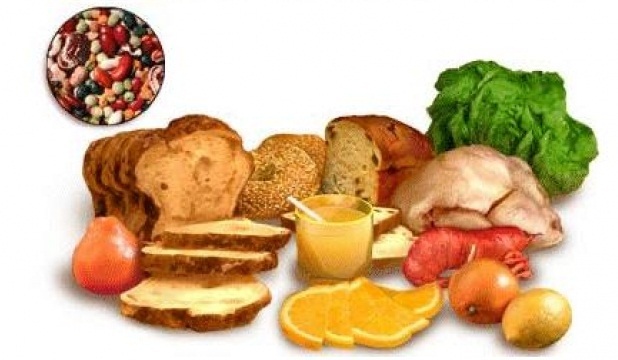
Folic acid enters the body from the outside and is produced by the symbiotic microflora of the large intestine.When storing food, the vitamin quickly breaks down.B6 is deposited in the liver, forming a reserve, which is enough for 3-6 months.
Why B9 is needed?
Folic acid is involved in protein metabolism, it is important for cell growth and division, as well as for the transfer of hereditary information.B9 is needed for the synetesis of neurotransmitters for the transmission of nerve impulses and blood cells.
Where is B9 contained?
In animal products of this vitamin is extremely small, in a more or less significant amount it is present in egg yolk, cheese and red fish.
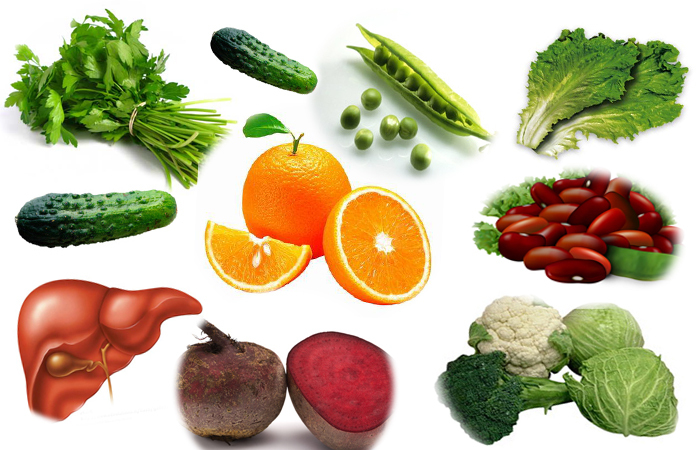
Plant products containing folic acid:
-
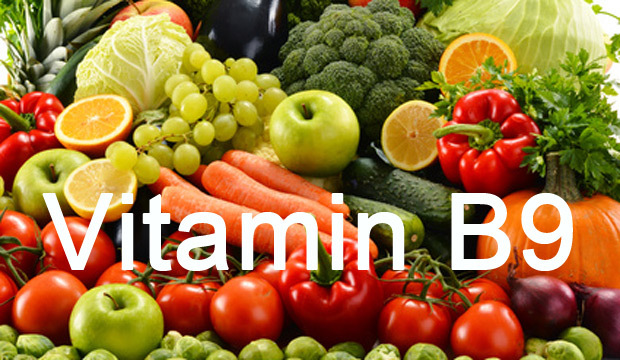 leafy greens;
leafy greens; - tomatoes;
- leguminous crops( beans, soybeans);
- potatoes;
- products from rye flour;
- nuts;
- cabbage( all kinds);
- beet;
- bananas;
- yeast( conventional and beer).
Hypovitaminosis
Deficiency of folic acid in pregnant women leads to pathologies of intrauterine development of the child( skeletal and fetal CNS suffer), and in the future - mental deviations in children.
Hypovitaminosis B9 can cause diseases of the digestive tract and blood pathologies.
Consumption norm B9
An adult a day needs 200 micrograms.It is recommended that breastfeeding women increase their intake of vitamin up to 300 micrograms.Children of the first year of life need 40 to 60 micrograms per day, and at the age of 1 to 3 years, 100 micrograms.In the older age, the norms of consumption are the same as in adults.
Hypervitaminosis
The safe amount is 600 μg.
Excessive intake of B9 in the body has a toxic effect, which is especially pronounced against a background of diseases such as epilepsy.
Vitamin B12( cyanocobalamin)
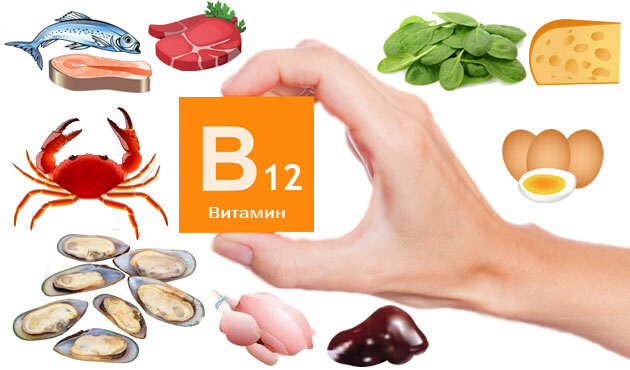 Vitamin B12 is a water-soluble substance, the structure of which includes a cobalt molecule.Cyanocobalamin has a property to be deposited in the body, mainly in the liver.
Vitamin B12 is a water-soluble substance, the structure of which includes a cobalt molecule.Cyanocobalamin has a property to be deposited in the body, mainly in the liver.
Most of the B12 organism receives alimentary way, and a comparatively small amount of the substance is synthesized by intestinal bacteria.To the effect of high temperatures, cyanocobalamin is fairly stable, but the activity of the vitamin decreases significantly when exposed to UV radiation, oxygen, and also in media with a pH shift to the alkaline or acidic side.
Why do I need vitamin B12?
B12 is required to obtain free energy from compounds containing calories.Thanks to this vitamin, the body freely absorbs amino acids and lipid compounds.Especially important is cyanocobalamin for those cells, the division of which is particularly active.This vitamin takes part in the biosynthesis of the protective myelin sheath of nerve fibers, as well as in the production of mediators responsible for the transmission of nerve impulses.B12 is needed for the ripening of red blood cells.It is able to stimulate the coagulation system and strengthen the immune system.Vitamin can reduce the total level of cholesterol in the blood plasma, preventing the development of atherosclerosis.In addition, B12 normalizes the functional activity of the liver.
Norms of vitamin B12 consumption
The daily need of an adult in cyanocobalamin, on average, 3 μg.The maximum safe daily volume is 9 μg.
During pregnancy and lactation, B12 consumption rises( the recommended dose is 4 μg per day).
Breasts up to 6 months should receive 0.4 μg of vitamin per day, and children from 6 months to 1 year - 0.5 μg.For children from 1 to 3 years, the norm is 1.0 μg, from 4 to 10 years - 1.5 μg, and from 5 to 10 years - 2.0 μg.The need for adolescents is the same as for adults.
Where is vitamin B12 contained?Sources B12 of animal origin: - liver( beef and pork);
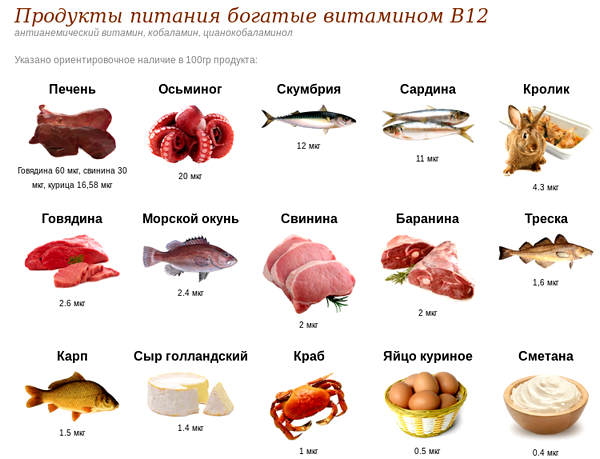
; Important: vegans need to take special dietary supplements and constantly monitor the sufficiency of vitamin B12 consumption due to its lack in plant foods. "Pseudovitamin B12" refers to substances similar to vitamin B12, contained in some living organisms, for example, in blue-green algae of the Spirulina genus, yeast, etc.These substances are especially dangerous for vegetarians who try to fill them with a vitamin B12 deficiency.It has been proven that they block the metabolism of human breast cells and provoke false blood test data when examining the concentration of vitamin B12. Characteristic manifestations of B12 deficiency are: Important: avitaminosis provokes the development of severe anemia.Acute deficiency is accompanied by diseases of the nervous system and threatens with mental disorders. Preparations B12 are administered in the following pathologies: Excess intake of water-soluble vitamin B12 does not have a toxic effect on the body. With the frequent administration of large doses, the development of congestive heart failure of pulmonary edema and peripheral vascular thrombosis is not ruled out. For more details on the signs and diagnosis of vitamin B deficiency, see the video review: Pseudovitamin B12
Hypovitaminosis
Indications for initiation of cyanocobalamin reception
Hypervitaminosis

